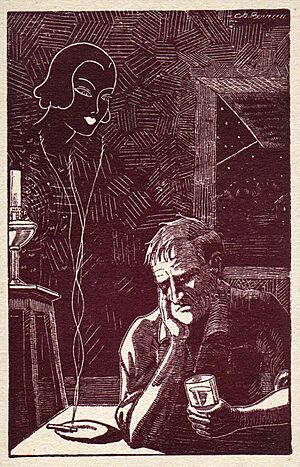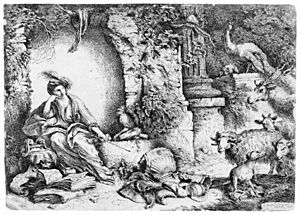Melancholia facts for kids
Melancholia or melancholy is an old word that describes a feeling of deep sadness. It comes from ancient Greek words meaning "black bile." For a long time, doctors in Europe, from ancient times through the Middle Ages and beyond, used this word to describe a condition where people felt very sad, had physical problems, and sometimes even saw or believed things that weren't real.
In the past, people believed that our bodies had four main liquids, called "humours." Melancholy was thought to be caused by too much "black bile." This idea was popular until the 1700s. Ancient doctors like Hippocrates described melancholia as a real sickness with both mind and body symptoms. These included feeling afraid and hopeless for a long time, not wanting to eat, having trouble sleeping, being easily annoyed, and feeling restless. Later, doctors like Galen added that people with melancholia might also have strong, fixed beliefs that weren't true.
During the Middle Ages, the understanding of melancholia changed. It was often seen as a sin or even a sign of demonic possession, rather than a physical illness.
However, in the late 1500s and early 1600s, especially in England, melancholia became a popular idea in art and literature. This was partly because a thinker named Marsilio Ficino changed how people saw it. Instead of being a bad thing, melancholia became a sign of being smart or even a genius. This "fashionable melancholy" showed up a lot in books, paintings, and music of that time.
From the late 1700s to the late 1800s, melancholia was a common medical diagnosis. Doctors then focused more on the strange beliefs people had, rather than just the sadness. In the 1900s, the word "melancholia" started to be used mostly as another word for depression. Today, doctors still use "melancholia" or "melancholic" in medical guides like ICD-11 and DSM-5. These terms help describe specific features that might be part of a major depression.
Contents
Melancholia in Early History

The word "melancholia" comes from an old medical idea called the four humours. This idea said that illnesses happened when there was an imbalance in four basic body liquids. It was also believed that your personality depended on which humour was strongest in you.
According to Hippocrates, a famous ancient Greek doctor, melancholia was caused by too much "black bile." That's why it's called "melancholia," meaning "black bile" in ancient Greek. If someone had a lot of black bile, they were thought to have a melancholic personality. In this old theory, black bile was connected to the element of earth, the season of autumn, the spleen organ, and qualities like cold and dryness. In astrology, it was linked to the planet Saturn, which is why you might hear the word saturnine to describe someone gloomy.
Doctors in the 4th and 5th centuries BC described melancholia as a specific illness. Hippocrates said that "fears and despondencies, if they last a long time," were signs of melancholia. Other symptoms he mentioned included not wanting to eat, feeling unable to make decisions, sleeplessness, being easily annoyed, and feeling restless. Many of these symptoms are similar to what doctors today look for in depression.
Melancholia in Ancient Rome and the Middle Ages
In ancient Rome, the doctor Galen added "fixed delusions" to the list of symptoms. These were strong beliefs that weren't true. Galen also thought melancholia could cause cancer. Another doctor, Aretaeus of Cappadocia, believed melancholia involved both deep sadness and delusions. In the 10th century, a Persian doctor named Al-Akhawayni Bokhari described melancholia as a long-lasting illness caused by black bile affecting the brain. He noted that people with it might have unexplained fear, give strange answers, laugh or cry for no reason, and speak nonsense, but without a fever.
During the Middle Ages in Europe, the idea that sadness was caused by body liquids became less popular. Instead, religious views became more common. Sadness was sometimes seen as a sin. If a patient couldn't be cured, people sometimes thought it was due to demonic possession.
Historians like Johan Huizinga noted that towards the end of the Middle Ages, a deep sadness seemed to affect many people. This sadness appeared in stories, poems, and even legal papers. People felt a sense of despair and believed the world was ending. This feeling of merencolie meant that serious thinking was often linked with sadness.
Painters were thought to be especially prone to melancholy. Writers like Vasari believed this could even make their art better, giving them more sensitivity and imagination. A famous picture by Albrecht Dürer called Melencolia I shows this idea. It's often seen as showing melancholia as a state of waiting for a creative idea, not just sadness.
One of the most detailed books about melancholia is The Anatomy of Melancholy (1621) by Robert Burton. He looked at the topic from both a literary and a medical point of view. Burton believed that music and dance were very important for treating mental illness. He wrote that music could cure despair and melancholy and even "drive away the devil himself."
Melancholia as a Cultural Trend

In the late 1500s and early 1600s, a fascinating cultural trend around melancholia grew in England. The art historian Roy Strong explained that this fashionable sadness came from the ideas of Marsilio Ficino. Ficino changed the old idea of melancholia from being a terrible humour to a sign of genius. This made it cool for artists and smart people to act and look melancholic.
Burton's The Anatomy of Melancholy was first published in 1621. It's a key book that shows how popular this idea was. Another important English writer, Sir Thomas Browne, also wrote about his melancholic feelings in his book Religio Medici (1643).
In art, you can often see this intellectual melancholy in portraits from that time. People would pose with crossed arms and a floppy hat over their eyes, or sitting with their head resting on their hand. These poses were common ways to show a "melancholy man." These portraits were often set outdoors, where nature could provide a thoughtful background, or in a dimly lit room.
In music, the composer John Dowland is linked to this trend. His motto was Semper Dowland, semper dolens, which means "Always Dowland, always mourning." In plays, William Shakespeare's character Prince Hamlet is a perfect example of the "Melancholy Dane."
Similar feelings of sadness and deep thought appeared in other art movements later on. For example, in Germany, the Sturm und Drang movement included works like The Sorrows of Young Werther by Goethe. In the Romanticism period, there was Ode on Melancholy by John Keats. These works explored deep emotions and a sense of sadness about the world.
Melancholia Today
Until the 1700s, most writings about melancholia focused on strange beliefs rather than just feelings of sadness. In the 1900s, the word "melancholia" started to be used mostly as a synonym for depression.
In 1907, a German psychiatrist named Emil Kraepelin suggested a condition called 'involutional melancholia'. He thought this could explain why older people often experienced depression. He believed that body changes in older age could lead to sad or anxious moods.
Today, the terms "melancholia" and "melancholic" are still used in medical classifications, like ICD-11 and DSM-5. They help describe specific features that might be present in major depression. These features can include:
- Feeling very sad, hopeless, or empty.
- Losing interest or pleasure in most activities that are usually fun.
- Not reacting emotionally to good things, like tasty food or friendly talks.
- Waking up very early in the morning, two or more hours before usual.
- Having very slow movements or being very restless.
- Losing a lot of appetite or weight.
In May 2020, BBC Radio 4 aired a series called The New Anatomy of Melancholy. It explored depression using ideas from Robert Burton's 1621 book.
See also
- Boredom
- Dysthymia
- Got the morbs
- Melancholic depression
- Mono no aware
- Nostalgia
- Pessimism
- Saudade
- Spleen
- Vapours (disease)
- Wit and Mirth, or Pills to Purge Melancholy





